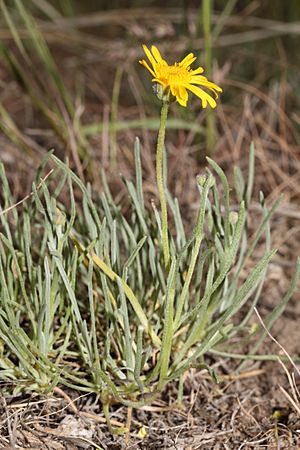Desert yellow fleabane facts for kids
Quick facts for kids Desert yellow fleabane |
|
|---|---|
 |
|
| Erigeron linearis in Wenas Wildlife Area in Washington | |
| Scientific classification | |
| Genus: |
Erigeron
|
| Species: |
linearis
|
| Synonyms | |
|
|
Erigeron linearis is a type of flowering plant. It belongs to the daisy family. People often call it the desert yellow fleabane or narrow-leaved fleabane.
Where Does It Grow?
Erigeron linearis grows naturally in the mountains of western North America. You can find it from British Columbia in Canada all the way south to Wyoming, northern Nevada, and Mono County in California.
What Does It Look Like?
This plant is a small, clumping perennial herb. This means it lives for more than two years. It can grow up to 20 centimeters (about 8 inches) tall. It has a strong, woody taproot that goes deep into the ground.
Its leaves are long and narrow. Most of them grow in a bunch around the bottom of the stem. They are usually 2 to 9 centimeters (0.8 to 3.6 inches) long and greenish-white. The stems stand up straight and are a bit hairy. They usually have only one flower head. Sometimes, they might have two or three.
Each flower head is about one centimeter (0.4 inches) wide. The center of the flower has many golden yellow disc florets. These are the tiny flowers in the middle. Around the edge, there are up to 38 pale to bright yellow or cream-colored ray florets. These look like petals. This plant likes to grow on open, rocky slopes. It often grows near plants like sagebrush, bitterbrush, or juniper.
Traditional Uses
Some Plateau Indian tribes used the desert yellow fleabane. They would make a poultice from it. A poultice is a soft, moist paste. They used this poultice to help treat sores.

